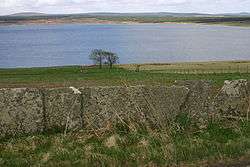Loch Calder
Loch Calder is a lowland freshwater loch lying approximately 5 mi (8.0 km) south west of Thurso in the Scottish Highlands. The loch is large with an irregular shape and has perimeter of 12.8 km (8.0 mi). It is approximately 2.33 mi (3.75 km) long, has an average depth of 21 ft (6.4 m) and is 85 ft (26 m) at its deepest. The loch was surveyed[3] on 6 October 1902 by John Parsons and T.R.H. Garrett and later charted[4] as part of Sir John Murray's Bathymetrical Survey of Fresh-Water Lochs of Scotland 1897-1909.
| Loch Calder | |
|---|---|
 | |
| Location | Caithness, Highlands Scotland |
| Coordinates | 58.516667°N 3.583333°W[1] |
| Type | freshwater loch |
| Primary inflows | Loch Olginey[2] |
| Primary outflows | Alltan Ghuinne[2] |
| Basin countries | Scotland |
| Max. length | 5 mi (8.0 km)[3] |
| Max. width | 1 mi (1.6 km)[3] |
| Surface area | 381.5 ha (943 acres)[1] |
| Average depth | 21 ft (6.4 m)[3] |
| Max. depth | 85 ft (26 m)[3] |
| Water volume | 767,000,000 cu ft (21,700,000 m3)[3] |
| Shore length1 | 12.9 km (8.0 mi)[1] |
| Surface elevation | 66 m (217 ft)[1] |
| Islands | 0[1] |
| 1 Shore length is not a well-defined measure. | |
Around the loch are several archaeological remains. At the northern end of the loch is Tulach an t'Sionnaich, a well preserved chambered cairn, one of two cairns known as the Tullochs of Assery.[5] On the eastern shore, near Achavarn, lies the site of a broch, although much of the structure has been removed.[6] It is thought that there was an artificial island or crannog near the western shore dating from the 17th century. The island, known as Big Island, may have contained a dwelling which was said to be that of a robber.[7] A short distance to the west of the loch is Aultan Broubster a ruined stone circle. Several of the stones remain, five of which are upright with the largest being 1.3 m (4 ft 3 in) high.[8]
The loch is a Scottish Natural Heritage Site of Special Scientific Interest for its Greenland white-fronted goose, Greylag goose and Whooper swans.[9]
The loch is popular for fishing and contains trout, Arctic char and ferox trout.[10]
References
- "Loch Calder". British lakes. British Lakes. Retrieved 12 June 2016.
- "Loch Calder". The Gazetteer for Scotland. Retrieved 12 June 2016.
- "Bathymetrical Survey of the Fresh-Water Lochs of Scotland, 1897-1909, Lochs of the Forss Basin". National Library of Scotland. Retrieved 12 June 2016.
- "Loch Calder; Loch Shurrery (Vol. 5, Plate 7), Bathymetrical Survey, 1897-1909". National Library of Scotland. Retrieved 12 June 2016.
- "Tulloch Of Assery". Canmore. Edinburgh: Historic Environment Scotland. Retrieved 2016-06-12.
- "Tulloch Of Achavarn". Canmore. Edinburgh: Historic Environment Scotland. Retrieved 2016-06-12.
- "Big Island, Loch Calder". Canmore. Edinburgh: Historic Environment Scotland. Retrieved 2016-06-12.
- "Aultan Broubster". Canmore. Edinburgh: Historic Environment Scotland. Retrieved 2016-06-12.
- "Loch Calder". Scottish Natural History information service. Retrieved 2016-06-12.
- "Caithness Lochs wild brown trout fishing". Troutquest. Retrieved 2016-06-12.